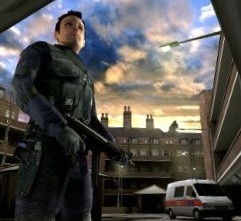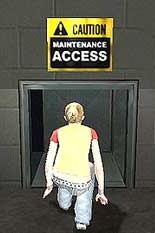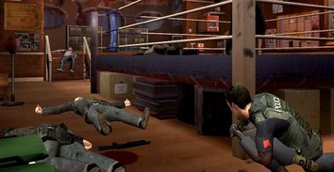 It’s a grey rainy evening in North London, and a tactical police unit prepare to take out a drug operation run by heavily armed Latvian mobsters. South of the river, a motley crew of down-and-out boxers and a sarcastic juvenile offender flesh out a plan to take down a major bank. In The Getaway: Black Monday, you’ll punch, shoot and sneak your way through the sordid underbelly of London and into the path of a powerful Eastern European billionaire with a shady past, as you struggle to survive and figure out just what the bloody hell is going on.
It’s a grey rainy evening in North London, and a tactical police unit prepare to take out a drug operation run by heavily armed Latvian mobsters. South of the river, a motley crew of down-and-out boxers and a sarcastic juvenile offender flesh out a plan to take down a major bank. In The Getaway: Black Monday, you’ll punch, shoot and sneak your way through the sordid underbelly of London and into the path of a powerful Eastern European billionaire with a shady past, as you struggle to survive and figure out just what the bloody hell is going on.
Editors Note: Today we’d like to introduce you all to VGB’s newest review writer: Stuart. No doubt after reading that review intro — and in time his future reviews — you’ll come to agree with us that he’s got the writing chops to inform you all about both classic and new videogames. Suitably introduced on a Monday, take it away Stuart! …
System: PS2 (exclusive)
Genre: Third-Person shooter, Driving
Release dates: January 11th 2005 (USA), November 12th 2004 (EUR)
Players: 1
Developer: Team Soho, renamed SCE London Studio
Publisher: Sony Computer Entertainment Europe
Origin: England
Rating: M for Mature (ESRB), 18 (BBFC)

In The Getaway: Black Monday, you play three characters over two interwoven story lines. Mitch is a hard-bitten firearms specialist with the Metropolitan police. He’s returning to the beat after suspension for shooting a suspect in the back and he’s a grumpy, defensive guy trying to prove himself in only job that he knows. After his team takes down a drug operation in North London, Mitch is given a prominent journalist to escort to a safe-house. She’s been investigating the organization of Viktor Skobel, the Russian billionaire, and fears for her safety. When she is abducted by unknown armed men, Mitch picks up the trail. Then there’s Eddie. He’s a boxer, all heart and knuckles, whose friends dabble more than a little on the wrong side of the law. They want Eddie to pose as a security guard in an elaborate scam they’ve set up which also involves Sam, a teenage hacker who’s served her time in juvenile detention for computer fraud and picked up a few gymnastic moves along the way. The scam goes inexplicably wrong and Eddie’s crew find themselves hunted by both the police and the criminal underworld. As London heats up and the bullets fly, it’s not certain who the better captors would be.
The sprawling backdrop of a faithfully reproduced London sets the scene for a deep and involving story, which blends driving on busy city roads with third-person shooting. While the city would seem to be the perfect setting for a sandbox style game, you are guided through the external environments in a fairly linear fashion, as most of the driving sections of the game are tied to an objective; tailing or destroying a vehicle, getting somewhere against the clock, and surviving or eluding pursuers. As with many other drive-and-shoot games, the player has the ability to stop and steal (or commandeer, in Mitch’s case) any other vehicle on the road, and the vehicles vary from volatile high-end sports cars all the way down to the painfully slow bulk of a red double-decker bus. The driving style is a compromise between the cartoony ease of the Grand Theft Auto games and the realism of racers like Gran Turismo. The Getaway takes place in a world where the streets of London are semi-realistically busy. It’s a world where there won’t always be enough room to pull off a perfect handbrake turn, where a flat tire will cripple the car, your brakes are your friends, and taking risks will only sometimes pay off.
 The story is told through frequent and very well acted cut-scenes. The look of each character in the game is heavily based upon the actor playing the part. Extensive facial and bodily motion capture was used so the voices perfectly suit the characters on screen. To begin with there seems little to link their stories, but the different threads are elegantly woven together and the final few chapters show everything in a different light. Your performance in certain chapters (13 and 18) will affect which of the four endings you get. I won’t ruin the enjoyable story by providing spoilers.
The story is told through frequent and very well acted cut-scenes. The look of each character in the game is heavily based upon the actor playing the part. Extensive facial and bodily motion capture was used so the voices perfectly suit the characters on screen. To begin with there seems little to link their stories, but the different threads are elegantly woven together and the final few chapters show everything in a different light. Your performance in certain chapters (13 and 18) will affect which of the four endings you get. I won’t ruin the enjoyable story by providing spoilers.
On foot, Mitch and Eddie carry weapons, while Sam is a completely stealth-based character. The shooting follows the same auto-target system as the first game, as well as the optional manual aim. The general on-foot control scheme seems conventional at first but takes some getting used to. It includes free-look, but when moving around in tight spaces the camera only allows rotation within a fixed radius, sometimes critically cropping your view.
Mitch, as a police officer, starts with regulation firearms and is limited in how many of the weapons found in the game he can pick up and use, but has the ability to subdue, arrest and handcuff enemy characters. Eddie can pick up and use all weapons, including assault rifles, machine pistols, handguns and sticks and bats, and he can dual-wield smaller guns. Even when unarmed the boxer’s fists are a potent force, making Eddie easily the most enjoyable character to play.
 Sam’s control scheme is very different. She has no weapons, but she can jump and climb. The controls are clunky and require practice, so expect some unintended responses at first. The stealth missions consist of making progress through levels while avoiding the line of sight of enemies, and as a teenage hacker she’s not equipped with any hi-tech motion sensors or radar, so a certain amount of trial and error is involved. Sometimes the missions rely heavily on moving through small spaces, meaning the shortfalls of the camera system are highlighted and can become frustrating, if overcome with a little creative maneuvering. The combat is intense and varies in scale, difficulty and scope throughout the game, with a gradual trend towards longer battles with more heavily armed and more mobile enemies towards the end. Where the controls generally seem heavy, the faster pace of combat proves them to be infuriatingly slow, a flaw which is especially obvious when you need to quickly turn when attacked from behind. Mitch can run into ammunition shortages due to his limited ability to scavenge weapons from fallen foes, which seems to make little sense as he is a police firearms specialist, but weapons are just plentiful enough to make it challenging rather than annoying.
Sam’s control scheme is very different. She has no weapons, but she can jump and climb. The controls are clunky and require practice, so expect some unintended responses at first. The stealth missions consist of making progress through levels while avoiding the line of sight of enemies, and as a teenage hacker she’s not equipped with any hi-tech motion sensors or radar, so a certain amount of trial and error is involved. Sometimes the missions rely heavily on moving through small spaces, meaning the shortfalls of the camera system are highlighted and can become frustrating, if overcome with a little creative maneuvering. The combat is intense and varies in scale, difficulty and scope throughout the game, with a gradual trend towards longer battles with more heavily armed and more mobile enemies towards the end. Where the controls generally seem heavy, the faster pace of combat proves them to be infuriatingly slow, a flaw which is especially obvious when you need to quickly turn when attacked from behind. Mitch can run into ammunition shortages due to his limited ability to scavenge weapons from fallen foes, which seems to make little sense as he is a police firearms specialist, but weapons are just plentiful enough to make it challenging rather than annoying.
The streets of London are modeled accurately and set the tone of different London boroughs, and with play passing through boxing gyms, snooker halls, sewers, factories, brothels, drug labs, gang hideouts and even over rooftops, you’re given a strong sense of delving behind the scenes of the city, but in this you’re restricted by the plot. As for interacting with the city, pedestrians will stop, stand and provide one of a disappointingly small pool of comments. Your fellow road-users will cry out when you crash into them, and you and your enemies exchange insults and challenges during gunfire, but it’s notable that all of the non-player characters have limited verbal responses to your actions, and they are frequently repeated as the game progresses.

What are the main features of The Getaway: Black Monday?
– Three distinctly different playable characters with their own skills, techniques and sense of humor (Mitch doesn’t have any)
– Excellent, engaging story, told through cut-scenes well animated with motion capture from the actors themselves. The score and voice acting throughout are of a very high quality.
– Sprawling road map of London with famous landmarks, including the Houses of Parliament, The London Eye, Nelson’s Column, Buckingham Palace and more. Most are not accessible but provide a convincing and immersive backdrop to the game. The widely varied interior playable environments are complex and believable with some interactivity.
– Go head to head with the Yardies, Russians, and the Collins Gang with auto-aim firing and optional free-aim, and you can even shoot (inaccurately) from cover.
– Wide variety of vehicles and weapons, from buses to sports cars and motorcycles, and sticks and clubs to pistols and assault rifles.
– Recover your health by catching your breath when leaning against walls. There is no health meter but bloodstains on your character’s clothes give an indication of his or her state of health.
– Four alternate endings dependent on performance in earlier levels, but they are undeclared and you may be unaware of which ending you are headed for.
– Extra missions available through the game menu. These are: Free Roaming (exploration mode), Taxi ‘Black Cab’ Missions, and Races. Collecting key rings scattered around the city in the Free Roaming mode unlock extras such as new vehicles and game characters for the races and free roaming.
Here’s a video of clips of in-game action:
As a combined driving and shooting game, The Getaway: Black Monday is inevitably compared with the Grand Theft Auto series, and it is not a comparison that it benefits from. The game is set in a large city map which is only slightly used in the main game mode, a bizarre fact when you consider that it was extensively researched and painstakingly modeled. Instead of a true sandbox game, Black Monday is a more direct, linear game where the modeled city of London is used to add depth and atmosphere. This is a linear game where you can still take wrong turns, get lost, get back on track and still make it to where you were going, or use your knowledge of the city (or the map) to try and avoid bottlenecks where roadblocks or ambushes might be set up. The simple surplus geography becomes almost a luxurious quality. You might get to know every inch of a map in a game where each mission introduces a new neighborhood, but in Black Monday you dash urgently from one place to another well within the extents of the map, so you feel like you might actually be somewhere real, somewhere with three dimensions, rather than playing in a world which the developer is at pains to ensure you appreciate at length.
It could also be possible that the intensive live-action motion capture methods and higher quality graphical animation standards for the cut-scenes in The Getaway mean that the plot simply cannot be sustained for as long or with as much variety as a Grand Theft Auto title. There’s only so much room on a disc, after all, and if you give with one hand you have to take away with the other.
Even if we optimistically assume that the balance of graphics versus gameplay was a calculated choice for The Getaway, there is a strange mix of integrity and unreality in the game. If you are wanted by the police, you are more readily recognized on a motorcycle than in a car, which makes sense. If you crash dramatically you might be thrown from the vehicle (especially likely on a motorbike) and you stand a high chance of not surviving. After receiving a large amount of damage, vehicles begin to smoke and will eventually catch fire if pushed too hard, but, logically, you can maintain a smoking car for longer at lower speeds. Pleasing little touches like these add realistic considerations to the gameplay, but on the other hand the health recovery system is a jarring dose of unreality. All you need to recover from gunshot wounds is a bit of a break from the action while you lean on a wall. You get your breath back and the blood disappears. No shooter could do without a method for player recovery one way or another, and anything that moves away from the tired old medikit is a nice change, but this is a really odd system.
SCORING
FUN FACTOR: 6.5
The characters’ personalities are likeable and enjoyable to play. The differences between them ensure the gameplay never gets old, but control is awkward, and this combined with the occasionally maddening camera can make for frustrating gameplay. It’s this control and camera issue that tragically detracts from a game that otherwise has great weapons and cover mechanics; driving, a wry sense of humor and a wonderful sense of place. There is a lot of fun to be had with Black Monday, but the actual controls are so cumbersome that it takes work and an act of will to immerse yourself in it.
Graphics: 8
The colors, shading and interactive elements of the city and internal environments are good. The weather in the city feels natural; it is at times gray, moody and foreboding, but view you get driving across the bridges can be beautiful if the sun is out. There is naturally a repetition of things like shop fronts, building types and so on, but the repetition is used creatively and is not always noticeable. The facial animation and body kinematics are great for the PS2, a result that really shows the investment of time and effort on Sony’s part, but out of all the characters in the game, Mitch alone seems unbelievable – his head is disproportionately large. Maybe the actor’s head is disproportionately large.
Audio: 8.5
Just shy of excellent. The background and environmental noise is perfect, the atmospheric score and theme music from Ninja Tune is fantastic, the main theme by Amon Tobin (who also wrote the score for Splinter Cell: Chaos Theory) is great, and the plot-related and main character voice acting is first-rate. The whole is only let down by the small pool of reactions from environmental non-player characters.
Ingenuity: 5
Released in 2005, after a slew of drive-and-shoot games that improved on a lot of the ideas already in the market, The Getaway: Black Monday reeks of a lot of money and production value applied to something which in the end sadly fails to gel together because of the poor core game controls. The progressions from internal to external environments are seamless, the pacing and response of the music to player actions is excellent, the draw distance effects and the great balance of reality and simplicity in the driving, all of this speaks of great care taken in the making of the game, but is not innovative or ingenious – merely well done.
Replay Value: 7.5
The alternate endings give you a slight motivation to return and try things differently, or better, but it’s the overall experience that, if you relish it the first time around, will draw you back in for another go. I replayed the game mostly for the sense of place, and you’ll understand why when I tell you I’m an Englishman living in New York City. Playing a game set in a quasi-believable London was a pleasure. Don’t let the events of The Getaway: Black Monday give you any wrong ideas, though. It was a lot quieter where I grew up.
